One of the best fan narratives to emerge from The Force Awakens was the suggestion of a romance between heroic ex-Stormtrooper Finn and the dashing fighter pilot Poe Dameron.
More than most fanmade “ships,” this one caught mainstream attention, receiving many media write-ups and enough speculation that even the actors have fun with Finn/Poe, and are used to genially fielding questions about it. But as we approach The Last Jedi‘s release, the fact remains that it is unlikely Disney will explore any pairing of the kind.
“Amateur scribes have created a thriving subculture organized around the romantic and erotic coupling of Oscar Isaac’s dreamy pilot, Poe Dameron, and John Boyega’s turncoat stormtrooper, Finn,” Vanity Fair told its audience in 2016 as a means of explaining the ship, which is known as “Finnpoe” or “Stormpilot.” And it’s not just fanfiction writers: there is a wealth of art, videos, blogs, tweets, and meta-commentary on the subject. The two indeed encompass a thriving subculture all their own.
The heat between the characters sprang from several scenes they share together in TFA, most famously a running hug and Poe’s insistence that Finn retain his jacket after they are reunited: “Keep it. It suits you,” Poe says, before an Oscar Isaac lip-bite seems to hint at more.
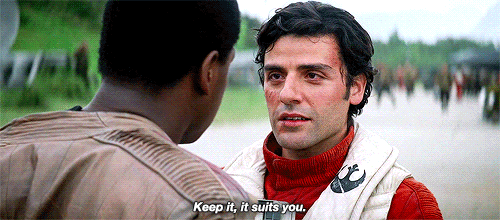
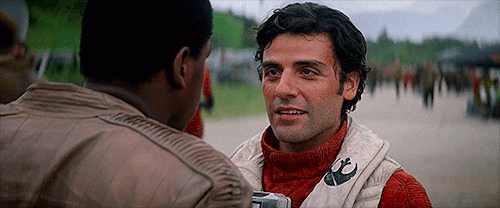
The relationship was popular with fandom after TFA‘s release—and continues to be years later—not only because two attractive men are involved, but because the match-up is culturally significant: two men of color, both prominent heroes on the right side of things, part of the biggest media franchise in this galaxy and those far, far away.
The Star Wars roots are also why Finnpoe spread into the mainstream, and why we’d get articles titled “Finn Spent the Night at Poe’s House Last Night, Guys” from decidedly non-fandom-y places like The Observer, when a magazine cover shoot depicted the actors leaning on each other and perhaps wearing each others’ clothes.
Personally, I love the idea of Finn/Poe. As far as “ships” go, it’s a particularly affectionate and loving one—”pure,” as we might say in internet parlance. Add in the congeniality and, well, the faces of John Boyega and Oscar Isaac, and you can’t go wrong. And the actors continue to tease good-naturedly:
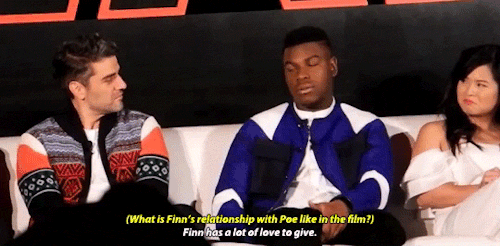
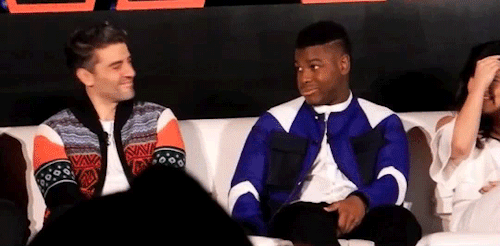
(via hupperts on tumblr)
Unfortunately, I cannot imagine that fans’ fervent hope that we’ll be tossed any sort of onscreen Finn/Poe “canon” confirmation will be the case. When you’re in fandom, surrounded by echoing voices, it’s easy to lose track of the fact that while you and several thousand other people might enthusiastically want a thing, movies like The Last Jedi are being made for a global audience on a mind-boggling scale.
Studios are thinking of how to capture millions, if not billions of people, as well as navigating huge markets like China, where LGBTQIA content is strictly regulated, if not outright banned. Disney and Lucasfilm are not going to jeopardize the reception of their biggest potential cash cow, and one of the most anticipated movies of the year, to satisfy the desires of a vocal minority of fans, no matter how dedicated.
In addition, it seems as though The Last Jedi will not be focused much on any kind of romance—which is a relief to those of us dreading the first trailer’s hint that Rey and Kylo Ren could team up. (“Reylo,” the portmanteau for that pairing, is subject to much controversy in fan circles, as Kylo is seen as an abusive figure for his torture of Rey in TFA. Also, like, the whole he-killed-his-father-Han-Solo thing. And betrayed his family and the New Republic. And killed an academy full of Jedis-in-training. And…) Last Jedi Director Rian Johnson told Vanity Fair:
For all the fan-fiction fantasies of “Reylo” (an imagined union of Daisy Ridley’s Rey and Adam Driver’s Kylo Ren) or “Stormpilot” (the same, for John Boyega’s ex-stormtrooper Finn and Oscar Isaac’s pilot Poe Dameron), Johnson says that The Last Jedi offers “no one-to-one equivalent of the Han-to-Leia, burning, unrequited love. In our story, that’s not a centerpiece.”
It appears that The Last Jedi, with a lot of action ground to cover, won’t be sparing much time for romance, which I think is fine given the narrative we’ve seen so far. And yet my shipper brain whispers to me: maybe Stormpilot doesn’t fall under “burning, unrequited love” because it’s totally requited! Let them love each other. Just leave me here in this Sarlacc pit with my ships, I’ll be fine.
I’d like to believe that fan culture has so influenced properties these days that we might at least get some significant scenes of Finn and Poe together. The popularity of their friendship is universal enough, and fandom can sustain itself indefinitely with another hug or a handshake and maybe some meaningful shared gazing as they plot for the First Order’s destruction. But that doesn’t stop us from wanting more, and from reading more into every bit of new information that emerges:
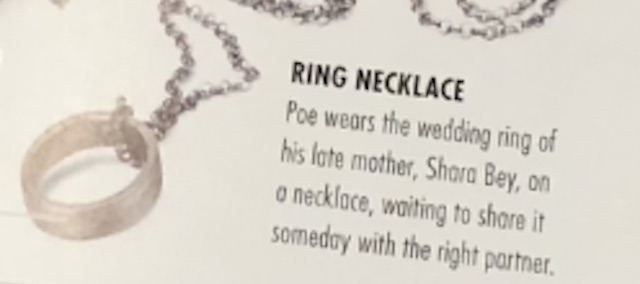
#StarWars paraphernalia seems to be going out of its way to give Poe Dameron a romantic prop that awaits a gender-unspecified recipient… pic.twitter.com/CV9aIWxtCJ
— Anthony Oliveira (@meakoopa) December 7, 2017
Me lookin for all the poe/finn confirmations like the space garbage I am pic.twitter.com/wCnZCb3Igf
— Hannah Rogers (@beehannahbee) December 7, 2017
We likely have Carrie Fisher to thank for Poe’s ring, as we have her to thank for many things:
another gift from our queen https://t.co/ap8WrNdvJK
— Anthony Oliveira (@meakoopa) December 7, 2017
In rehearsals Carrie grabbed my arm and told me with great urgency that we needed “space jewelry.” I thought that was a fabulous idea. So.
— Rian Johnson (@rianjohnson) November 3, 2017
While Finn/Poe may never receive the kind of representation onscreen that fans are longing for, I’m left feeling two strong feelings. The first is that it’s wonderful that we now live at a place in time where we can have these conversations at all, and primary creatives and mainstream outlets openly discuss and engage with them.
When “A Fragment Out of Time,” widely considered to be the first piece of published Kirk/Spock slash fiction, showed up in a Star Trek zine in 1974, the story was purposefully written so “poetically vague” as to conceal the identity and the genders of the characters within. Years later, I grew up in a fandom culture full of fear, an era when studios sent cease-and-desist letters to writers and story archives, alleging intellectual property infringement.
Times have changed considerably, and are much better for the recognition of fans’ creativity and the importance of representing a diversity of identities beyond the still-rigid mainstream “norms.” Transformative works have come a long way and carved out a place for themselves: they will remain.
Yet despite my relief that things are better than they were in my youth, we’re still so far away from seeing something like Finn/Poe in Star Wars or Steve/Bucky in the MCU that it’s hard not to feel furious about it. That’s my second strong emotion: disappointed anger. Books, comics, and television have all worked to catch up to the realities of our changing world, and now frequently depict a multiplicity of identities and relationships. Yet movies that are not specifically art-house in nature lag preposterously behind. When it comes to genre blockbusters, the idea that we’ll get to see a loving LGBTQIA couple on-screen—and centrally placed—feels dizzyingly out of reach.
Consider what we’ve seen recently: Hikaru Sulu in Star Trek: Into Darkness getting a husband and a daughter, but a kiss between the men was edited out. LeFou in Beauty and the Beast receiving a blink-and-you-miss-it acknowledgment that he’s “gay” that caused a global firestorm of media attention and controversy. Similar wall-to-wall headlines about the sexuality of the new Yellow Power Ranger, with the unacknowledged allusion that she might possibly have “girlfriend problems.” And just last month, a scene cut by Marvel from Thor: Ragnarok that would have confirmed Valkyrie’s canonical bisexuality.
The studios are running scared, and they are very much out of line with the times. There’s a catch-22 at hand in that positive and open representations by major movies would go a long way towards their acceptance by more mainstream audiences, and yet the studios, frightened of blowback therein, refuse to give us the fully-rounded LGBTQIA heroes that we deserve.
Films often develop relationships in a kind of shorthand, with inadvertent touches and lingering looks and any terms of endearment or banter between heterosexual couples putting a neon ROMANCE sign over their heads so that we know they’ll end up together. But when same-sex characters are shown to do the same, they’re just friends. They’re buddies. Pals. There’s nothing else to see here, the creative people with the power to change that insist.
So in the meantime, fans will do what we’ve always done: we’ll continue to create what we want and need to have represented on our own, and let the rest of the world play catch-up.
[The Mary Sue staff accounts this video our cinematic masterpiece]
(images: Vanity Fair, Disney, Tumblr)
Want more stories like this? Become a subscriber and support the site!
—The Mary Sue has a strict comment policy that forbids, but is not limited to, personal insults toward anyone, hate speech, and trolling.—



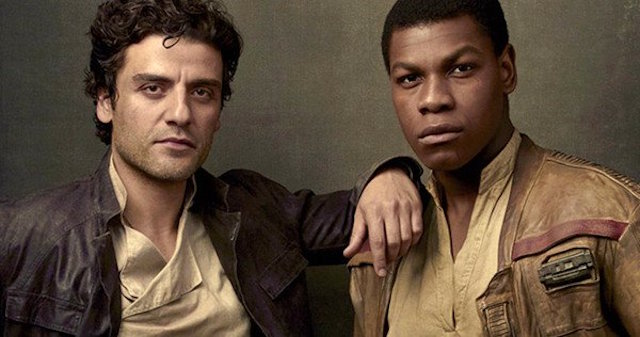
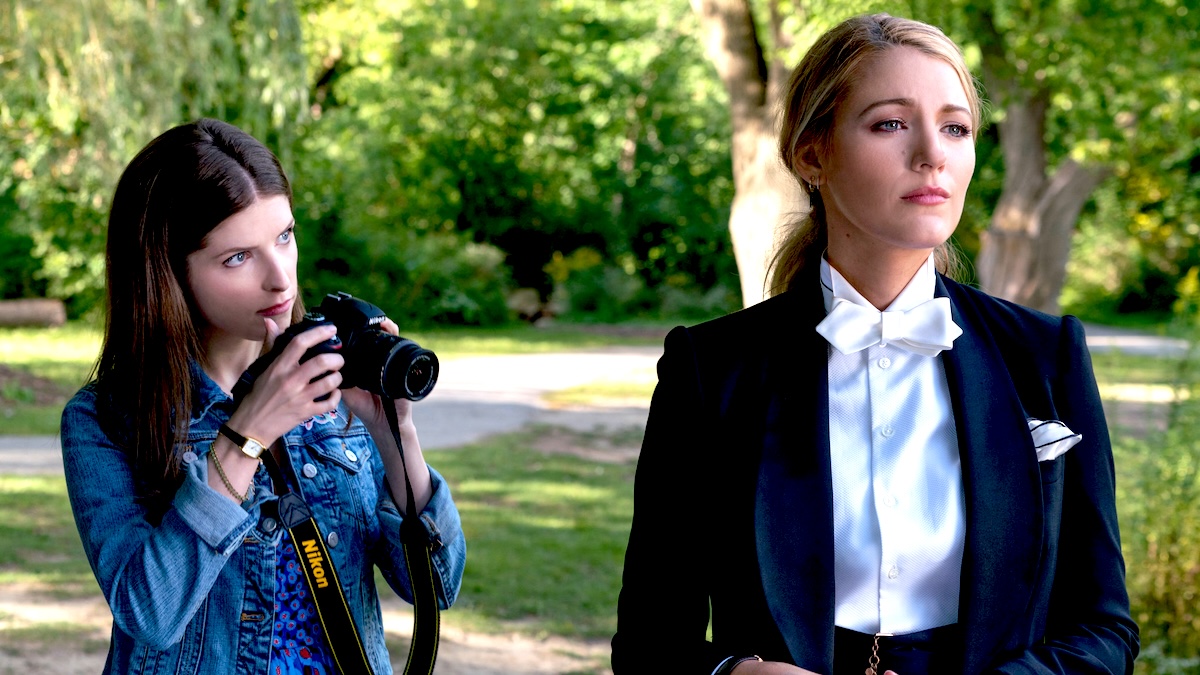

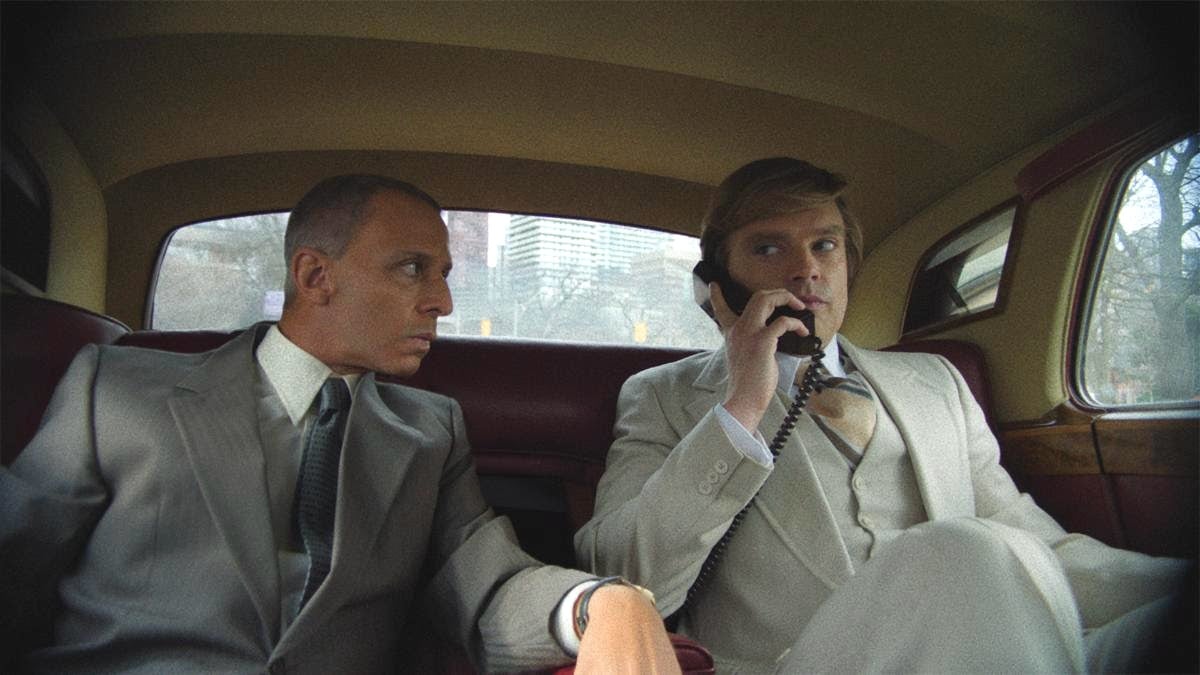
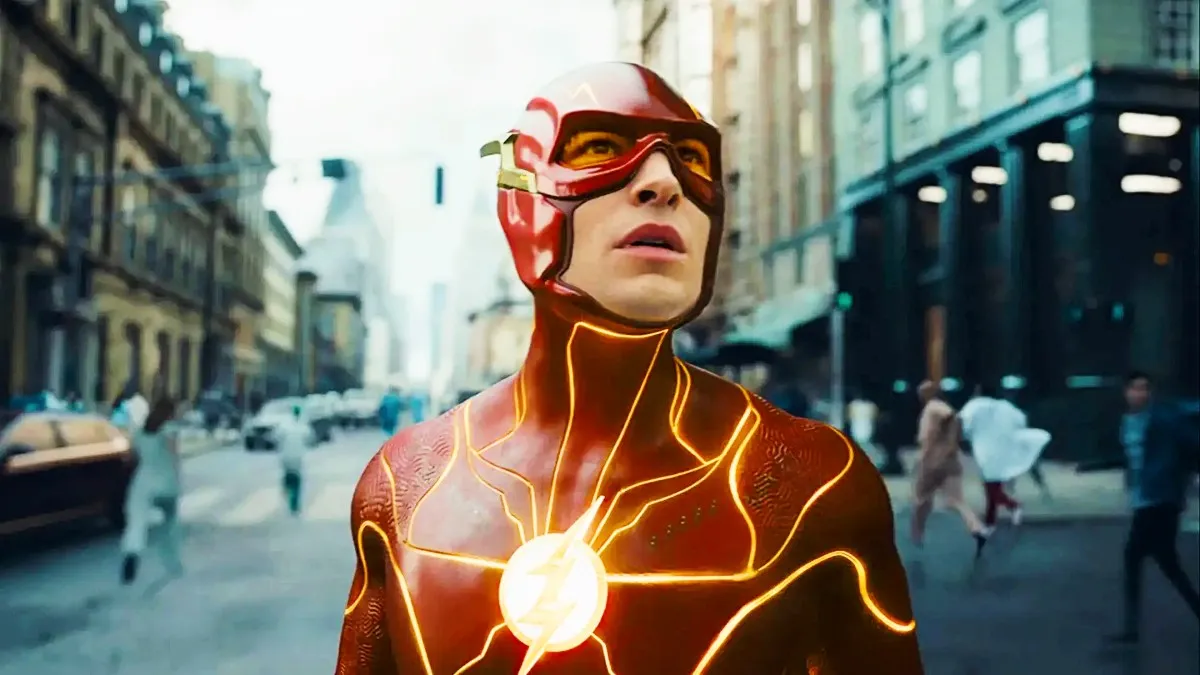


Published: Dec 7, 2017 03:32 pm